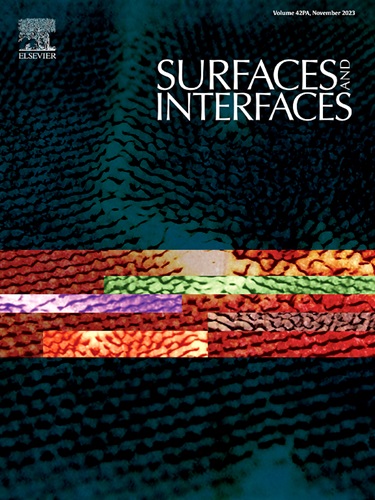Anticorrosive studies of Chitosan/TiO2/g-C3N4 composite on mild steel in saline and acidic conditions
IF 5.7
2区 材料科学
Q2 CHEMISTRY, PHYSICAL
引用次数: 0
Abstract
This work focuses on the synthesis of a nanocomposite coating that enhances the anticorrosive property of the metal. The nanocomposite under study is a synergistic blend of chitosan, titanium dioxide (TiO2), and graphitic carbon nitride (g-C3N4), effectively challenging the corrosion problem faced by various industries. The environment-friendly and natural properties of chitosan, the photocatalytic activity of TiO2 nanoparticles, and the efficient electrical conductivity of g-C3N4 make the composite an ideal material for studying anticorrosion activity. Experimental techniques like XPS, XRD, HR-TEM, FE-SEM, TGA, BET surface area, and FTIR analysis have been employed to characterize the nanocomposite. Weight loss studies indicate the efficacy of the nanocomposite on mild steel in 3.5 % NaCl and 1 M HCl. The corrosion behavior of the nanocomposite is examined by Tafel curves and electrochemical impedance analysis. The results indicate that the inhibition efficiency of chitosan/TiO2/g-C3N4 nanocomposite is 99 % with a charge transfer resistance value of 152.43 Ω , which is more effective in the corrosion inhibition of mild steel than chitosan, TiO2, and g-C3N4 when taken separately. The anticorrosive coating prepared using this composite can be applied on different surfaces under various environmental conditions to reduce corrosion.

求助全文
约1分钟内获得全文
求助全文
来源期刊

Surfaces and Interfaces
Chemistry-General Chemistry
CiteScore
8.50
自引率
6.50%
发文量
753
审稿时长
35 days
期刊介绍:
The aim of the journal is to provide a respectful outlet for ''sound science'' papers in all research areas on surfaces and interfaces. We define sound science papers as papers that describe new and well-executed research, but that do not necessarily provide brand new insights or are merely a description of research results.
Surfaces and Interfaces publishes research papers in all fields of surface science which may not always find the right home on first submission to our Elsevier sister journals (Applied Surface, Surface and Coatings Technology, Thin Solid Films)
 求助内容:
求助内容: 应助结果提醒方式:
应助结果提醒方式:


